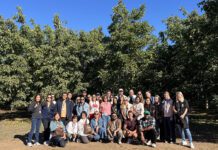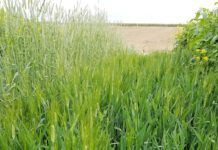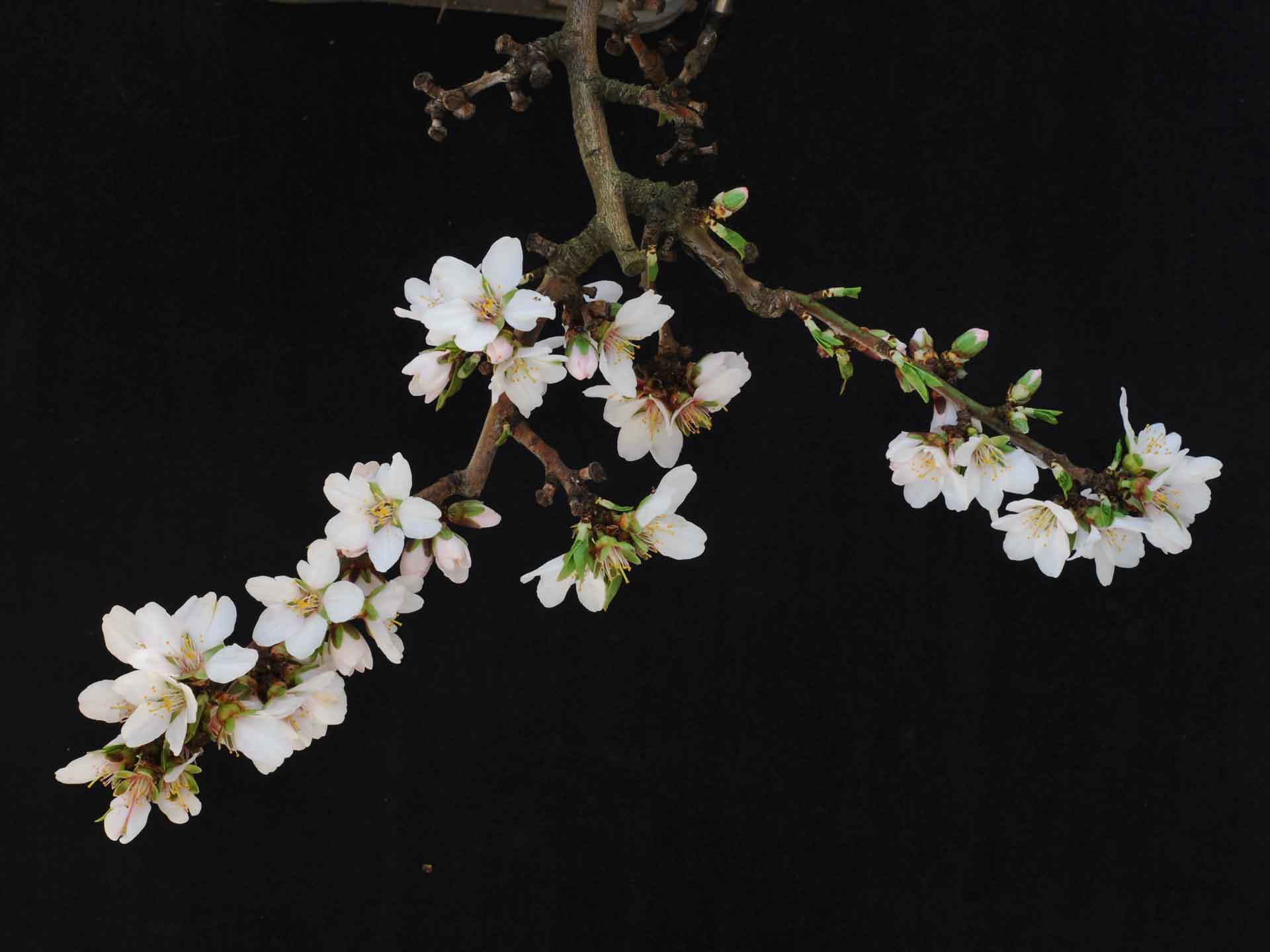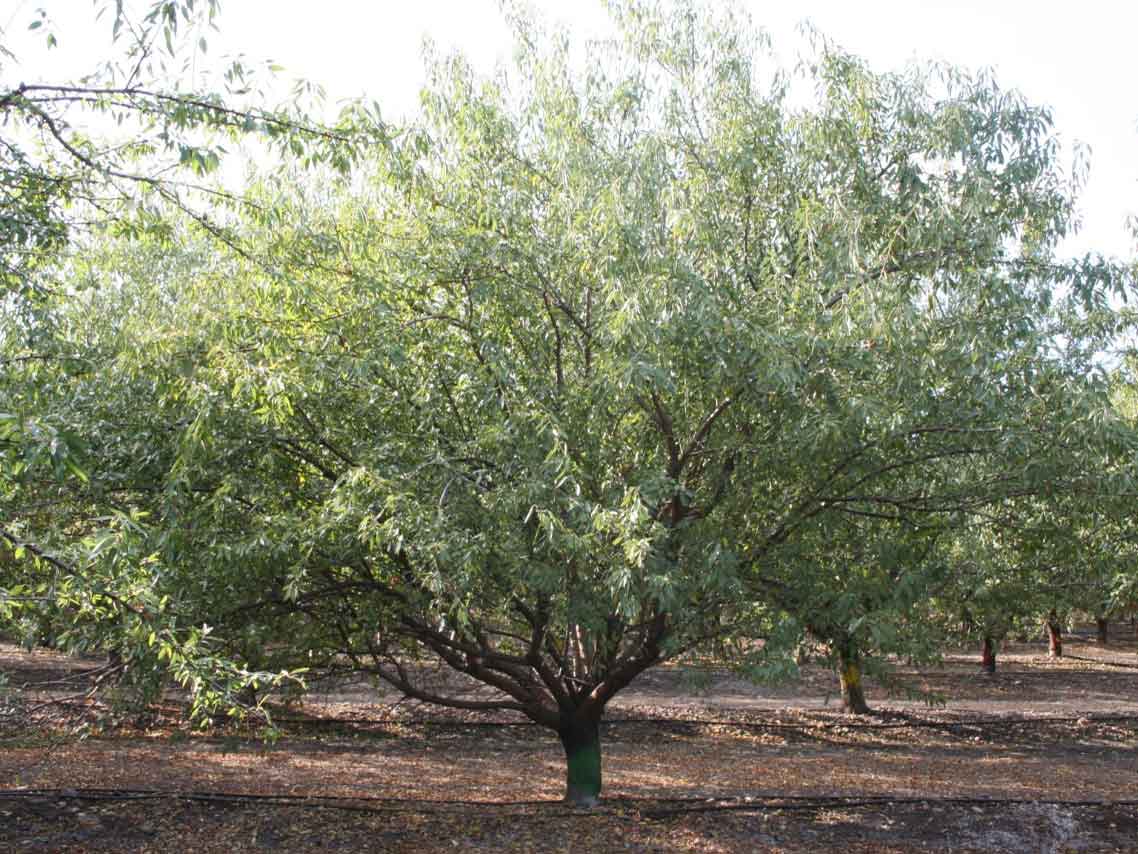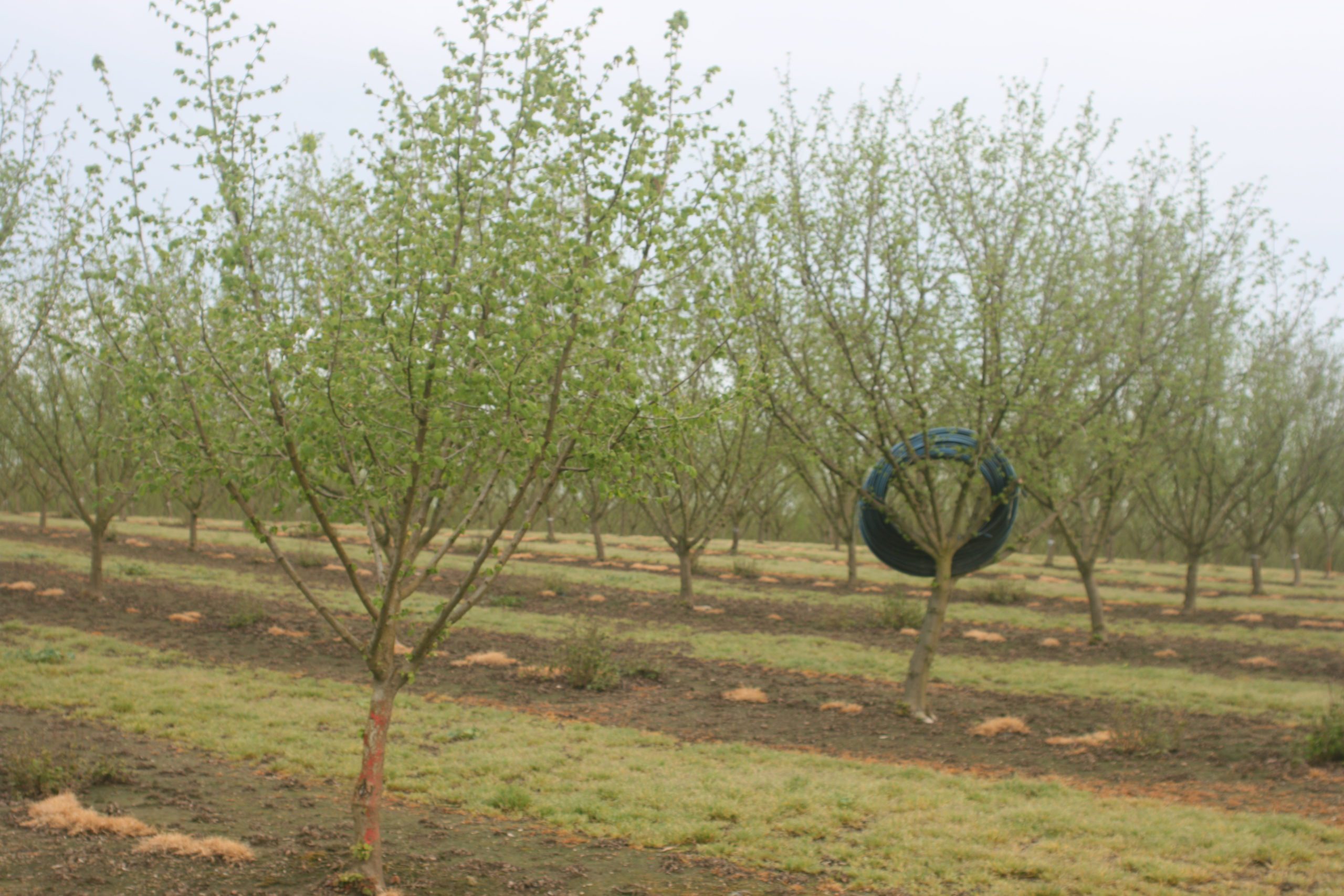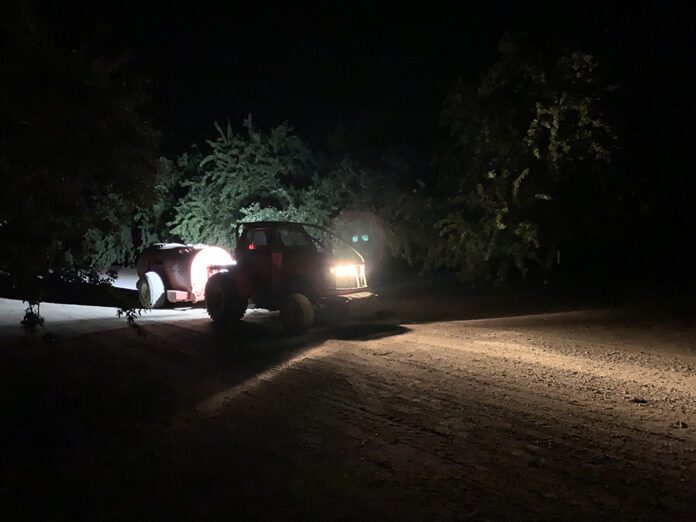
In a Nutshell: Listen to the Summary
Summer is here and hull split is just weeks away. June is when kernel dry weight begins to accumulate rapidly and the flower buds for the next crop (2026) begin to develop. Beginning in June, almond growers are farming two crops: this year and next year. Income per acre comes down to several factors:
• The number of nuts in an orchard
• Individual kernel weights
• Nut quality
Flower number sets the potential for nut number and flower buds differentiate beginning at hull split and develop through the summer and into fall. That’s why summer and fall orchard conditions this year have such an impact on the crop next year. Through the summer, but starting in June, it’s very important to avoid sustained water stress, nutrient deficiency, particularly nitrogen and potassium, and premature leaf loss to maintain crop potential for next year.
The bulk of almond kernel weight accumulates in June and July. This dry weight increase is fueled by carbohydrates produced by photosynthesis in the leaves. Reductions in carbohydrate production (especially sustained water stress and/or defoliation) in June and July reduces kernel weight at harvest. While research results vary, it is not uncommon to see 10% kernel weight reduction (lost yield) reported when sustained water stress occurs from June until harvest. Even moderate stress (5 bars below baseline) if sustained from June until harvest can significantly reduce final kernel weight and yield without leaf loss or other obvious sign of stress.
Water
Keeping up with irrigation is job No. 1 in June. Adequate soil moisture permits well-hydrated leaves to optimize photosynthesis, which translates to carbohydrate production. Those carbohydrates are the building blocks of kernel dry weight, so extended periods of inadequate plant available water means lost kernel weight (and grower income).
There are many options for irrigation monitoring and management. At least one should be used frequently as the core irrigation planning tool. These include evapotranspiration crop water use (ETc) estimate, soil moisture sensors, plant moisture monitoring and/or hand feel using a shovel or auger. Using several methods to manage irrigation, perhaps a core practice and one or more tools to double check that practice will keep the orchard between the red lines of water stress and overirrigation. For example, using ETc to determine crop water use and irrigation needed to replace it could be the primary tool and a pressure chamber could be used to periodically check the stress level of trees in the orchard to double check the ET-based irrigation program.
Short periods of managed, moderate water stress at hull split (i.e., strategic deficit irrigation or SDI) can help manage a major disease problem: Rhizopus hull rot. There is no need to use SDI when soil or irrigation system issues already impose chronic summer tree stress.
The goal for SDI is to apply moderate water stress (-14 to -18 bars using the pressure chamber; roughly 4 to 8 bars below baseline) for a two-week period beginning at first hull split. Then return the orchard to full irrigation (-10 to -14 bars; 0 to 4 bars below baseline) until irrigation cutoff at harvest. To be able to apply the targeted stress at hull split, irrigation sets should be shorted (not eliminated) ahead of hull split. Deficit irrigation may need to start weeks ahead of the timing of needed stress (hull split), depending on the amount of soil moisture reserves and irrigation system type. Cutting back on irrigation water ahead of the target window for moderate stress (two weeks after first hull split) causes trees to use up extra existing root zone soil moisture and allows the trees to reach the target stress by first hull split. The pressure chamber provides the plant stress data needed to deliver and hold moderate water stress for the prescribed two weeks.
Using SDI may also help tighten up hull split and limit irregular nut maturity, thus “speeding” harvest and limiting risk of shaker damage in orchards with natural variability in soil moisture due to soil texture or terrain differences.
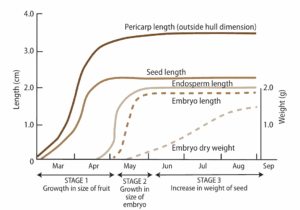
Pests and Diseases
June is the month for ants, spider mites, stink bugs and navel orangeworm (NOW). The following is advice/information from UC IPM Guidelines (ipm.ucanr.edu), UC IPM advisors and specialists, and experienced PCAs. Consult with your PCA for materials, rates and timings best suited for your orchard operation. Always read the label.
Navel orangeworm
Hull split is fast approaching and a critical time for NOW management begins. Once almond hulls split, the nuts can be located by pregnant female NOW looking to lay eggs. While the earliest hull split is generally in late June in the Sacramento Valley, it’s important to work with your PCA to get the materials selected and delivered to your operation plus focus on scouting to catch the early signs of hull split for the best spray timing.
The first hull split spray should be completed by 1% hull split. Experienced PCAs tell me early hull split timing is the most successful in helping manage NOW damage. Once blank nuts start to split, it’s getting close to “go” time. A tardy first hull split spray can let NOW lay eggs on unprotected nuts in your orchard and increase nut damage despite the money (material, time, equipment) spent putting on the spray. In Nonpareil/pollinizer plantings, the first hull split spray using long-lasting materials that target eggs and young larvae (e.g., Altacor, Intrepid) need only go on the Nonpareil as those materials are primarily intended to control eggs or young larvae on the splitting nuts. If a pyrethroid (e.g., Brigade, Warrior) is in the tank, a solid spray is suggested as that class of materials targets all NOW life stages and can help control adults in the pollinizer trees even though nuts in those trees have not split.
Stink bugs
Brown spot damage is caused by true bug (stink bugs and leaffooted bug) feeding on nuts. By June, the focus on bug control shifts from leafooted to stink bugs. Look for gumming nuts in clusters and egg masses as indicators of a stink bug problem. Stink bug management can be a tough call as brown spot damage is considered a defect and in turn a reject. Additionally, the only effective insecticides providing lasting stink bug control are pyrethroids and using those materials risks flaring spider mites.
Ants
Almost the perfect crime: Crop loss with little to no evidence. Ants can eat so much of a kernel that what’s left is blown out during harvest or processing, a reason to do a harvest sample to catch losses before sweeping and picking up.
To avoid ant damage, check now for protein-feeding ant presence in orchards and treat with ant bait when monitoring shows a need (not all ants eat almonds, some help control pests.) Ant bait takes time to work as the bait target is the queen and developing larvae. All baits can work when carefully applied. Some work slowly with long effect and must be applied many weeks ahead of harvest.
Effective bait is the key to ant control. If the oil used as bait is rancid, it doesn’t attract ants. For best results, use fresh bait, apply no sooner than 24 hours after irrigation and don’t irrigate for 48 hours after spreading bait.
Spider Mites
Last fall, experienced PCAs told me abamectin wasn’t working for them and up to four miticide sprays were needed to control spider mites in some areas of the Sacramento Valley. I can remember how easy (and less expensive) weed control was when glyphosate (Roundup) worked on pretty much all weeds. What would spider mite control look like in a world where abamectin (e.g., AgriMek) no longer works?
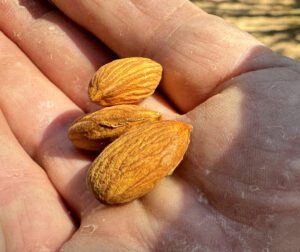
There is good news to counter this nightmare scenario:
• Predator mites and insects can control spider mites without use of miticides where those “good bugs” are allowed to thrive (no pyrethroids or other broad-spectrum pesticides). Kern County miticide use is dropping under this program.
• To my knowledge and experience, abamectin is still effective. However, UC research showed more than 10 years ago that two-spotted spider mite populations repeatedly treated (four years in a row) with abamectin are less sensitive to it over time. Increased tolerance can develop, and resistance is possible.
So, heading into another hot summer, spider mite management should be very carefully addressed. Where pyrethroids aren’t used, biocontrol can be effective or at least help provide a safety net for a pest control program that doesn’t include materials harmful to beneficial insects and mites. Where a mite spray is needed, careful application practices (complete coverage) are critical to control. Selecting a miticide that doesn’t harm beneficial insects and mites lets biocontrol work in the background, helping suppress spider mites that poor coverage might have missed.
Hull rot
Successful management of Rhizopus (black bread mold) hull rot requires a trifecta of control practices: adequate leaf N (<2.6%; 2.4% or 2.5% is better), RDI at hull split and effective fungicide or alkaline phosphorus material with first hull split spray. If Monilinia hull rot is the target, an early June fungicide is the recommended timing. See the UC IPM Fungicide Efficacy and Timing publication for rating of effective materials.
Alternaria
In certain microclimates with high relative humidity after sunset and little to no air movement, alternaria leaf spot can infect and prematurely defoliate almond orchards. I have seen more of this disease in recent years with substantial leaf drop occurring in some locations. Varieties most vulnerable to this disease include Carmel, Sonora, Winters, Butte, Monterey, Nonpareil, Winters and, in my experience, Independence. This disease doesn’t need rain to infect leaves; high humidity and temperatures can produce dew and long leaf wetness periods which promote infection. Check with your PCA about alternaria conditions in your orchard and growing area.
Finally, here’s a key point that impacts all spray pest management in summer. Running a sprayer through the orchard does not equate to a mission accomplished. Even with the right materials in the tank, a poor spray job (timing and/or coverage) has a very good chance of disappointing all involved. Uniform coverage, especially in the treetops where most of the nuts grow, is critical to successful pest control and return on investment in the spray. Slow ground speed, adequate spray volume, nozzle/canopy targeting, and conditions at spraying (light wind, >40% RH) all contribute to good spray coverage, especially in summer when the canopy is the thickest and good coverage the toughest to get.
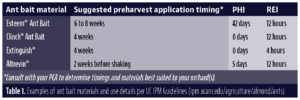
Nutrition
Most of the annual N budget in almonds should be completed by now. Especially in orchards with a history of hull rot, July leaf levels should be under 2.6%. Check with your CCA regarding summer N strategy.
Almond K use continues through July driven by nut accumulation of this macronutrient. To maintain spur health and bloom levels for the 2026 crop, avoid deficiency (1.0% leaf K) in the July leaf sample. It is too late to recover spur health if July levels are deficient, so a June leaf sample can provide a preview of the July levels with time for a correction if needed. Leaf K levels generally decline over time, so if a June leaf level for an orchard is already deficient or between deficient and adequate (1.4% leaf K), a quick fertigation of a moderate amount of K (e.g., 25 to 50 lbs K2O/acre) should keep the July level above deficient. That’s just my opinion; please check with your CCA to decide what’s best for your orchard.
Mark your calendar for leaf sampling in July and harvest sampling when the nuts are drying (just before windrowing), a good time to see ant damage and get a real measure of NOW damage. Also, hull samples for boron analysis should be taken from the windrows just before pickup.
Shaking is still a couple months away, but a preharvest equipment checkup with an experienced mechanic/technician may avoid costly breakdowns during crunch time later this summer. Some shops offer preharvest discounts.
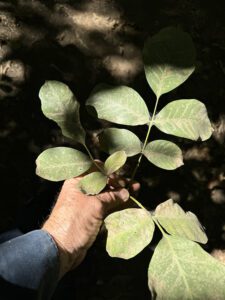
Walnuts
As I write this in early May, it’s too soon to know how the walnut crop will shape up. Hopefully, the crop will rebound from very low levels seen in many orchards last year. Here are a couple reminders:
• Husk fly traps should be up by June 1.
• Codling moth traps, spider mites and predators should be monitored weekly.
Best wishes to all for a good summer.
Resources
General
Articles and info (weekly ET, nutrition, meetings, pictures, etc.) This is a site developed and maintained by UCCE Orchard Advisors in the Sacramento Valley: sacvalleyorchards.com
Pest information with photos: ipm.ucanr.edu/almonds and ucipm.ucanr.edu/walnuts
Almond statistics and forecast: nass.usda.gov/Statistics_by_State/California/Publications/Specialty_and_Other_Releases/Almond/
Specific topics/titles:
Using ETc to irrigate: sacvalleyorchards.com/et-reports/irrigating-using-etc/
Soil moisture sensors: sacvalleyorchards.com/blog/soil-moisture-sensor-selection-is-confusing/
Pressure chamber info:
• What is baseline? youtube.com/watch?v=F1xwJVAyQ3A
• sacvalleyorchards.com/manuals/stem-water-potential/advanced-swp-interpretation-in-almond/
• Using the pressure chamber for nuts and prunes: anrcatalog.ucanr.edu/Details.aspx?itemNo=8503#FullDescription
The Almond Doctor (David Doll) on irrigating almonds:
• Google “Irrigating almonds through the summer”
Ants: ipm.ucanr.edu/agriculture/almond/ants/
Spider mites: ipm.ucanr.edu/agriculture/almond/webspinning-spider-mites
Monitoring six-spotted thrips for mite management: youtube.com/watch?v=ufJ4VCa-IFI
Navel orangeworm: ipm.ucanr.edu/agriculture/almond/navel-orangeworm/
Brown Marmorated Stink Bug: youtube.com/watch?v=fc2qv7YtaWU
Fungicide efficacy and timing (at the bottom of the page): ipm.ucanr.edu/agriculture/






